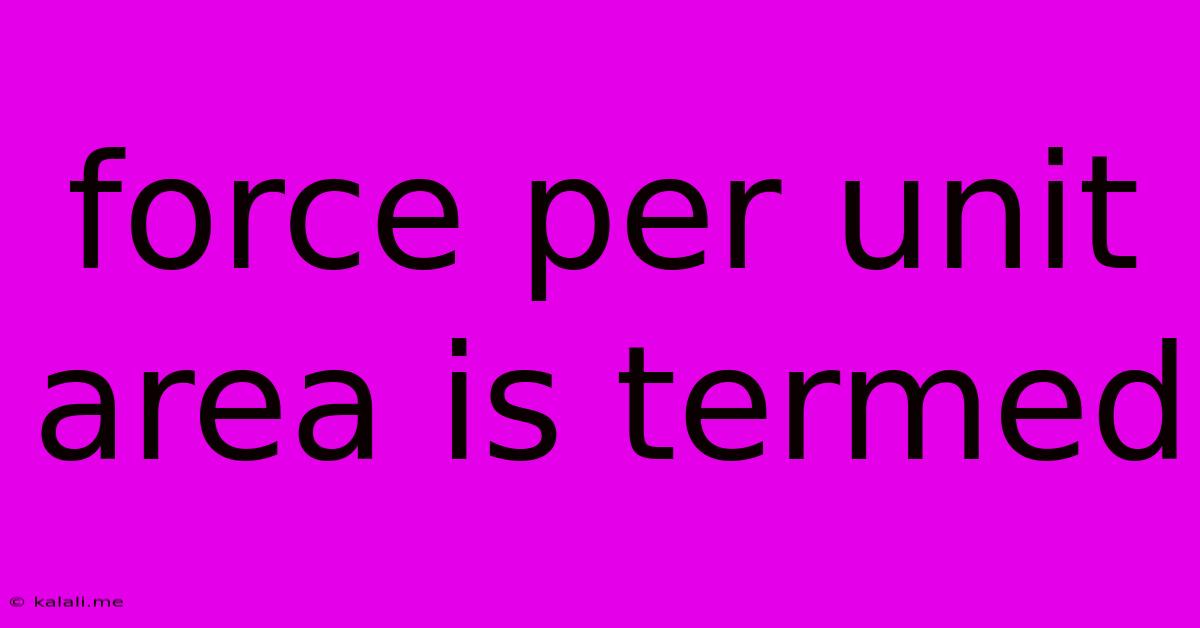Force Per Unit Area Is Termed
Kalali
Jun 15, 2025 · 3 min read

Table of Contents
Force Per Unit Area is Termed: Understanding Pressure and its Applications
Force per unit area is termed pressure. Understanding pressure is crucial in various fields, from everyday life to complex engineering applications. This article will delve into the definition of pressure, its units of measurement, and explore its significance in diverse contexts. We'll also examine related concepts and explore how pressure affects different systems.
Pressure is a fundamental concept in physics and engineering. It quantifies the amount of force applied perpendicularly to a surface area. A higher force concentrated on a smaller area results in greater pressure, while the same force spread over a larger area results in lower pressure. This relationship is crucial in understanding how pressure impacts different materials and systems.
Understanding the Formula for Pressure
The formula for calculating pressure is straightforward:
Pressure (P) = Force (F) / Area (A)
Where:
- P represents pressure, typically measured in Pascals (Pa).
- F represents force, usually measured in Newtons (N).
- A represents area, typically measured in square meters (m²).
This simple equation highlights the inverse relationship between pressure and area: increasing the area while keeping the force constant reduces the pressure, and vice-versa.
Units of Pressure: More Than Just Pascals
While Pascals (Pa) are the SI unit for pressure, several other units are commonly used, depending on the application. These include:
- Atmospheres (atm): Often used in meteorology and chemistry, representing the average atmospheric pressure at sea level.
- Pounds per square inch (psi): Commonly used in engineering and industrial applications, especially in the United States.
- Bars and Millibars (bar, mbar): Frequently used in meteorology and other fields requiring high precision.
- Torr: Used in vacuum technology and other specialized applications.
Understanding the conversion factors between these units is essential for accurate calculations and interpretations.
Applications of Pressure: A Wide-Ranging Impact
Pressure plays a vital role in numerous areas, including:
- Fluid Mechanics: Pressure gradients drive fluid flow in pipes, rivers, and the atmosphere. Understanding pressure is critical in designing efficient piping systems, predicting weather patterns, and analyzing aircraft aerodynamics.
- Material Science: Pressure significantly impacts the properties of materials. High pressure can alter the structure and behavior of materials, leading to novel applications in materials processing and synthesis.
- Medical Applications: Blood pressure, a crucial indicator of health, is a direct measure of the pressure exerted by blood on artery walls. Understanding and managing blood pressure is essential for maintaining cardiovascular health.
- Engineering Design: Pressure considerations are vital in designing structures like dams, bridges, and buildings. Engineers must account for pressure exerted by liquids, gases, and external forces to ensure structural integrity.
Related Concepts: Beyond the Basics
Understanding pressure often involves grasping related concepts like:
- Absolute Pressure: The total pressure exerted at a point, including atmospheric pressure.
- Gauge Pressure: The difference between absolute pressure and atmospheric pressure.
- Hydrostatic Pressure: The pressure exerted by a fluid at rest due to gravity.
- Dynamic Pressure: The pressure associated with the motion of a fluid.
These concepts are interconnected and crucial for comprehensive understanding of pressure and its applications.
In conclusion, understanding the concept of force per unit area, termed pressure, is paramount across numerous scientific and engineering disciplines. Its applications are vast, impacting our daily lives in ways we may not even realize. Mastering this fundamental concept and its related terms allows for a deeper understanding of the world around us and opens doors to innovative applications in various fields.
Latest Posts
Latest Posts
-
The Light Year Is A Unit Of
Jun 15, 2025
-
What Is The Least Common Multiple Of 12 And 40
Jun 15, 2025
-
What Is The Prime Factorization Of 160
Jun 15, 2025
-
Which Reinforcement Schedule Is Most Effective
Jun 15, 2025
-
Which Word Is An Antonym Of Lament
Jun 15, 2025
Related Post
Thank you for visiting our website which covers about Force Per Unit Area Is Termed . We hope the information provided has been useful to you. Feel free to contact us if you have any questions or need further assistance. See you next time and don't miss to bookmark.